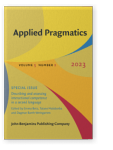Commentary
Challenges of assessing interactional competence
Article outline
- 1.Introduction
- 2.Challenges of CA-SLA for L2 assessment
- 3.Moving forward
- 4.Conclusion
-
References
References (13)
References
Couper–Kuhlen, E., & Selting, M. (2018). Interactional linguistics. Cambridge University Press.
Dingemanse, M., Roberts, S. G., Baranova, J., Blythe, J., Drew, P., Floyd, S., et al. (2015). Universal principles in the repair of communication problems. PLOS ONE,
10
(9). 

Enfield, N. J., & Sidnell, J. (2014). Language presupposes an enchronic infrastructure for social interaction. In D. Dor, C. Knight, & J. Lewis (Eds.), The social origins of language (pp. 92–104). Oxford University Press. 

Hall, J. K. (2018). From interactional competence to interactional repertoires: Reconceptualizing the goal of L2 learning. Classroom Discourse,
9
(1), 25–39. 

Hall, J. K. (2019). The contributions of conversation analysis and interactional linguistics to a usage-based understanding of language: Expanding the transdisciplinary framework. The Modern Language Journal,
103
(51), (
supplement
), 80–94. 

Heritage, J. (1984). Garfinkel and ethnomethodology. Polity Press.
Kendrick, K. (2017). Using conversation analysis in the lab. Research on Language and Social Interaction,
50
(1), 1–11. 

Levinson, S. (2006). On the human ‘Interaction Engine’. In N. J. Enfield & S. Levinson (Eds.), Roots of human sociality (pp. 39–69). Berg.
Schegloff, E. (1990). On the organization of sequences as a source of ‘coherence’ in talk-in-interaction. In B. Dorval (Ed.), Conversational organization and its development (pp. 51–77). Ablex.
Schegloff, E. (2006). Interaction: The infrastructure for social institutions, the natural ecological niche for language, and the arena in which culture is enacted. In by N. J. Enfield & S. Levinson (Eds.), Roots of human sociality (pp. 70–96). Berg.
Seedhouse, P. (2019). The dual personality of ‘topic’ in the IELTS Speaking Test. ELT Journal,
73
(3), 247–256. 

Stivers, T. (2008). Stance, alignment and affiliation during storytelling: When nodding is a token of affiliation. Research on Language and Social Interaction,
41
(1), 31–57. 

